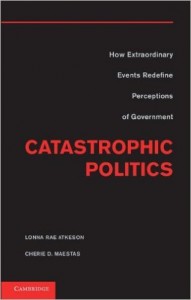Ten years ago, just days after Hurricane Katrina barreled through New Orleans leaving in its wake chaos and devastation, researchers Cherie Maestas, now of UNC Charlotte, and Lonna Atkeson, of University of New Mexico, were preparing a national public opinion survey to understand the American public’s reaction to the intensely emotional news coverage of the storm.
Their study found striking evidence of how the emotionally evocative footage that drew nearly universal attention from the public spawned strong emotional reactions of fear and anxiety and changed the way individuals processed information in the media about the causes of the chaotic aftermath in New Orleans. The 10th anniversary of the storm offers a time to look back at their findings.
Their book, Catastrophic Politics: How Extraordinary Events Redefine Perceptions of Government, (2012, Cambridge University Press) used the case of Hurricane Katrina to examine the more general processes through which extraordinary events reshape public perceptions of government, how they become catalysts for change, and why they become long standing symbolic touchstones in society.
 The researchers found that catastrophes like Hurricane Katrina can create moments in which government accountability can flourish, even in a divided political landscape. This occurs because a shocked public becomes willing to critically examine the performance of all leaders, even those of their own political party, the researchers suggested. Atkeson and Maestas showed that the emotional assignment of blame towards government following Hurricane Katrina helped to create bipartisan, support for investigative oversight, policy changes in the management of disasters, and restrictions on the appointment powers of presidents.
The researchers found that catastrophes like Hurricane Katrina can create moments in which government accountability can flourish, even in a divided political landscape. This occurs because a shocked public becomes willing to critically examine the performance of all leaders, even those of their own political party, the researchers suggested. Atkeson and Maestas showed that the emotional assignment of blame towards government following Hurricane Katrina helped to create bipartisan, support for investigative oversight, policy changes in the management of disasters, and restrictions on the appointment powers of presidents.
Hurricane Katrina remains a powerful symbol of government failure and neglect ten years later. References to Katrina appear regularly in policy debates as a symbolic metaphor and cautionary tale of powerful political fallout when government is shown to be unprepared or slow to respond. It is invoked in in debates as far ranging as gun control, social policy, racial inequality, and economic policy. It is also used as a benchmark in assessing the performance of leaders in the US and beyond in nearly all subsequent major disasters.
Symbols like Hurricane Katrina are powerful because, when invoked, they stimulate not only memories of the event but the associated emotions from the events – emotions that can spill over to shape the debate in which the symbol was applied, Maestas said.
Catastrophic moments become powerful symbols because they are universally shared by members of the public and imbued with emotion and meaning, she said. “Catastrophes attract the attention of the rich and poor, the young and old, the educated and uneducated, and, importantly, the politically engaged and disengaged,” she said. “Unlike ordinary politics that ebb and flow around at the periphery of the day-to-day moments in our personal lives, major catastrophes pull us away from the ordinary, compel our attention, and motivate us to try to understand the “what” and “why” of the catastrophe.”
When the story becomes political, even those who are ordinarily uninterested in news about government are suddenly, unexpectedly, exposed to emotionally intense evaluations of government performance by the press and by those experiencing the catastrophe.
The ten-year anniversary of Hurricane Katrina provides an important collective moment in which the public, the press, and political leaders can stop to reflect on the meaning of the catastrophe then and now, and to assess progress towards rebuilding the lives of those who were affected, Maestas said. This reflective look back also provides a mechanism for assessing whether society has effectively implemented the public policy lessons learned from Hurricane Katrina, she said.
“Catastrophes, whether natural or man-made, extract a tremendous human toll – one that we hope never to have to pay,” she said. When catastrophes inevitably happen, though, the work by Atkeson and Maestas suggests that the groundswell of public emotion can be harnessed to enhance democratic accountability and encourage policy change.
Image: Aerial views of damage caused from Hurricane Katrina the day after the hurricane hit August 30, 2005. Photo by Jocelyn Augustino/FEMA.








